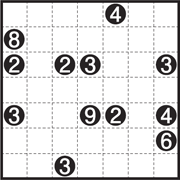Shikaku
Players: 1
Ages: 7 and up
Cost: Free Download! (Or buy a book - affiliate link)
Math Ideas: spatial reasoning, logical deduction, area of rectangles, primes and composites
Questions to Ask:
Which ways could you place this rectangle?
Which rectangles could contain this open space?
There is a whole category of grid-based puzzle games that folks love. Sudoku is the most popular of course, but there are all sorts of other games that play around with the form in interesting ways.
There is one variation I've found that combines the fun and challenge of solving a sudoku with other vital mathematical ideas that kid should interact with often. If I could wave a wand, I'd replace every Sudoku book in every airport with a book of these puzzles.
They're called Shikaku.
How to Play
I was introduced to Shikaku by Jessica McConnell, who has used it in her own classroom. I've tried it out with adults and kids, and it's always a hit. You can find some sample puzzles at this site, and plenty of other Shikaku puzzle sites are a Google search away. Or you can buy a book of them from Amazon! (affiliate link)
You start with a square grid made up of smaller squares, sort of like Sudoku. In some of those squares are numbers. That number tells you the area of a rectangle that contains the number. See that 3 in the top row of this image? I need to draw a rectangle with an area of 3 that contains the 3-square.
There are a couple of other rules: Every rectangle can only contain a single number, and every square on the game board must be placed inside some rectangle.
And that's it! From here, it's a game of logical deduction. Not every rectangle is immediately clear. For example, I could draw a vertical 1X3 rectangle or a horizontal 3x1 to contain that 3 in the top row. But somewhere on the puzzle is a rectangle that can only fit one way. Your kid's job is to find that rectangle and draw it in.
Then, just like in Sudoku, you use that information to deduce the location of other rectangles. Pretty soon, you hit the point in the puzzle where all the dominoes start to fall into place, and evenytually you've cordoned every square off into its own rectangle.
These puzzles are immensely satisfying.
Where's the Math?
Shikaku have all the great deductive attributes of Sudoku. Your child will sharpen their logical reasoning by playing these puzzles, without a doubt.
But the true power of Shikaku, and the reason they are my favorite grid puzzles, is the way that they embed important math topics into the puzzle.
For example, every number must fit inside a rectangle whose area matches the number. So obviously your child will spend a great deal of time thinking about the areas of rectangles.
And it turns out that some areas are easier to make than others. For example, I can make a rectangle with an area of 12 in many different ways. I could make a 4x3 rectangle, a 6x2 recangle, or a 12x1 rectangle. And each of those I could orient in a vertical direction or a horizontal direction. Tons of choices!
But then there are other areas, like 7. It's harder to imagine a rectangle with an area of 7. In fact, I can only think of a long skinny 1x7 rectangle, either pointed vertically or horizontally.
And there are other numbers like 7 that only have one type of rectangle you can make. Numbers like 2, 3, 5, 11, 13, and so on...
See what I mean? These puzzles give your child an intuitive understanding of prime and composite numbers. When they interact with that idea later in school, they'll have an existing mental model of rectangles that they can use to build a deeper understanding of how those numbers relate to other ideas in mathematics.
Questions to Ask
When I introduced my son to these puzzles, I found that he developed confidence when I would ask him a question that focused his attention on a specific strategy. So first, I chose to focus on the numbers. I'd ask
How could you draw a rectangle that would contain this number?
In this example, you might draw your child's attention to the 8 in the 2nd row. Could you draw a 1x8 rectangle? No, it wouldn't quite fit across the board. What about a 2x4 rectangle? Sure, that would fit!
Now your child has a new strategy that they can use to attack the pzuzle. Look at each number and imagine how to contain it within a rectangle.
You can also ask a question to teach a complementary strategy:
Which rectangles could contain this blank square?
Again, look at the example. In the very bottom righthand corner is an open square. Which rectangles could contain it? Well, the only option is the 6. No other rectangle could reach all the way to that corner.
Again, you've drawn your child's attention to a strategy: every square must be contained in some rectangle, so you can test each square to see if there is a unique rectangle that contains it.
If you really want to get advanced, you could ask your child
Can you invent your own Shikaku puzzle?
If you do that, get ready. You might have created a puzzle-making monster. But at least they'll do plenty of math along the way!
Click here to buy a book of Shikaku puzzles from Amazon (affiliate link)







